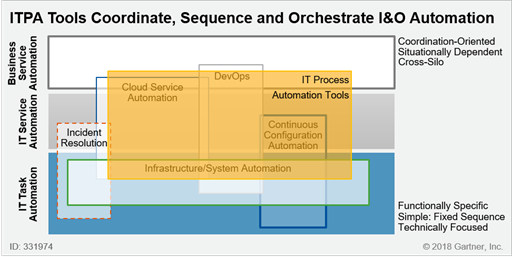The 2018 Gartner Market Guide for IT Process Automation (ITPA) delivers insights about the current state of automation in enterprises and actionable recommendations for ITOps teams seeking to evolve automation initiatives to the next level. In this blog, let’s look at what’s working today and what’s needed to help ITOps teams move along the automation continuum.
Automation is indeed a stated goal for most – if not all – ITOps teams. After all, the benefits of automating across processes, technology stacks and systems can be significant – labor efficiencies, cost savings, increased agility to support the business, better service levels, consistent governance and compliance practices to name just a few. In this latest version of the ITPA Market Guide, Gartner paints the picture that very few enterprises are achieving the level of automation that delivers these benefits. In fact, they make the point that “ITPA tools remain aspirational automation targets for most I&O leaders, who are focused on task-level automation.”
This issue of task automation vs. process automation is an important one in the context of overall automation initiatives. Most ITOps teams are automating tasks specific to one purpose and it’s often done in an adhoc and disjointed way with the resulting benefits being minimal. Automation projects hit a wall because they are done in isolation without focusing on the overall outcome. While it may deliver some short-term efficiency gains, random task automation is not a long-term strategy. ITOps teams need to focus on how task automation efforts are driving towards a holistic automation approach. Gartner represents this in the below graphic, showing the transition from IT task automation to IT Service Automation to Business Service Automation.

Gartner notes that very few enterprises are at the level of Business Service Automation with most being at the task level. In the current environment of increased complexity, multi-platform, multi-cloud, rapid increases in data quantity and the need to keep up with the pace of DevOps, automation is key to the success of ITOps teams. So, what can be done to progress the automation agenda and avoid getting stuck in low-value task automation?
Gartner recommends that I&O leaders focus on the following to make IT process automation a central tenet in ITOM:
- Drive skills development
- Review and change organizational design
- Invest in Automation tools and training
- Proactively support automation initiatives
Additionally, Gartner recommends a strategic approach to automation with careful assessment of organizational automation objectives and priorities and avoid continuing to “opportunistically automate with limited strategic vision.” Existing successes in task-level automation are a good place to start, building on that task automation to orchestrate across more complex services.
Many BMC customers are evolving from task automation to IT process automation by using TrueSight Orchestration to link tasks together and automate workflows to address pain points in ITOps processes. Two key use cases include:
Automated Event Remediation: automating the triage and resolution of events that have standard remediation processes with orchestration across the monitoring and service management processes. With the amounts of data organizations and IT Ops teams have to manage exponentially growing, this automation use case helps take IT Operations from incident response to automated, proactive problem management.
Closed-Loop Change and Compliance Management: ITOps teams are automating change and configuration processes to address the need to maintain compliance while supporting DevOps initiatives that drive shorter release cycles and rapid change. This enables IT Ops needs to create audit ready processes to drive compliance while reducing labor cost, errors and governance risks.
IT process automation initiatives like these are being achieved with out-of-the-box content to speed workflow setup and time to value which is in line with Gartner’s recommendation to “‘Maximize automation investments by selecting ITPA tools that can orchestrate workflow execution across functional requirements, groups and management tools.”
Outcomes from these automation initiatives are driving significant change and efficiencies across ITOps processes, including benefits such as:
- reductions of 60% in Mean-time-to-repair (MTTR) of operational issues
- 83% reduction in time spent remediating events
- 30% decrease in cost of audit preparations
An important takeaway for I&O leaders from this latest Gartner ITPA report is that implementing automation in a meaningful way involves moving beyond task automation to process automation and eventually to service orchestration. This requires a strategic automation approach and an ITPA tool with the out-of-the-box content and flexibility to support business automation imperatives.
These postings are my own and do not necessarily represent BMC's position, strategies, or opinion.
See an error or have a suggestion? Please let us know by emailing blogs@bmc.com.






